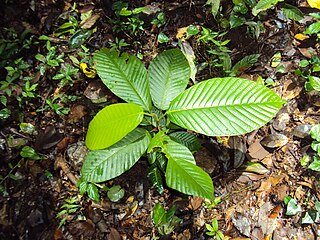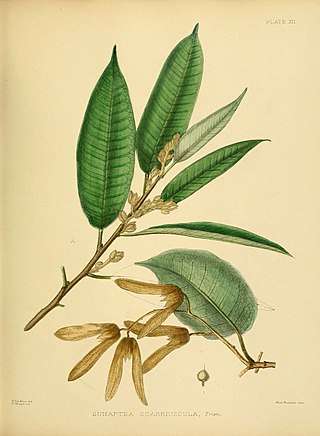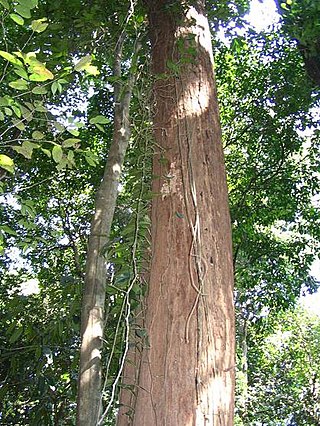
Dipterocarpaceae is a family of flowering plants with 22 genera and about 695 known species of mainly lowland tropical forest trees. Their distribution is pantropical, from northern South America to Africa, the Seychelles, India, Indochina, Indonesia, Malaysia and Philippines. The greatest diversity of Dipterocarpaceae occurs in Borneo.

Shorea is a genus of about 196 species of mainly rainforest trees in the family Dipterocarpaceae. The genus is named after Sir John Shore, the governor-general of the British East India Company, 1793–1798. The timber of trees of the genus is sold under the common names lauan, luan, lawaan, meranti, seraya, balau, bangkirai, and Philippine mahogany.

Dipterocarpus is a genus of flowering plants and the type genus of family Dipterocarpaceae.
Cotylelobium melanoxylon is a tree in the family Dipterocarpaceae. The specific epithet melanoxylon means "black wood", referring to the dark colour of the tree's wood. It was first described by Joseph Dalton Hooker in 1860 as Anisoptera melanoxylon and transferred to Cotylelobium by Jean Baptiste Louis Pierre in 1889. It is the provincial tree of Surat Thani Province, Thailand.
Shorea teysmanniana is a timber tree of the family Dipterocarpaceae. It occurs in Sumatra, Peninsular Malaysia and Borneo.

Hopea is a genus of plants in the family Dipterocarpaceae. It contains some 113 species, distributed from Sri Lanka and southern India to the Andaman Islands, Myanmar, southern China, and southward throughout Malesia to New Guinea. They are mainly main and subcanopy trees of lowland rainforest, but some species can become also emergent trees, such as Hopea nutans.

Parashorea is a genus of plant in family Dipterocarpaceae. The name Parashorea is derived from Greek and refers to the genus similarity to Shorea. It contains about 14 species distributed from South Myanmar, Thailand, Indo-China and the southernmost parts of China to Sumatra, Borneo and the Philippines.

Parashorea macrophylla is a species of plant in the family Dipterocarpaceae. The name macrophylla is derived from Greek and refers to the species extremely large leaves. It is endemic to Borneo, being found in Brunei, Sarawak and West Kalimantan. The timber is sold under the trade name of white lauan or white seraya. It occurs in protected areas in Sarawak but elsewhere it is threatened by habitat loss.
Neohopea isoptera is a species of flowering plant in the family Dipterocarpaceae. It is the sole species in genus Neohopea. It is a tree endemic to Borneo. It is native to lowland mixed dipterocarp forest up to 500 meters elevation, where it is a canopy tree growing up to 60 meters tall.

Stemonoporus is a genus of plants in the family Dipterocarpaceae. The genus is endemic to Sri Lanka. It contains as many as 26 species, all but one confined to the perhumid forests of the island.

Vatica is a genus of plants in the family Dipterocarpaceae. Its species range from India and southern China through Sri Lanka, Indochina, Indonesia, the Philippines, and New Guinea.

Cotylelobium is a genus of plants in the family Dipterocarpaceae. The name Cotylelobium is derived from Greek and describes the receptacle. It contains five species distributed in Sri Lanka, Peninsular Thailand, Sumatra, Peninsular Malaysia and Borneo. All five species are listed on the IUCN redlist, as either vulnerable, endangered or critically endangered.

Anisoptera is a genus of plants in the family Dipterocarpaceae. It contains ten species distributed from Chittagong in southeast of Bangladesh to New Guinea.
Cotylelobium lanceolatum is a tree in the family Dipterocarpaceae. The specific epithet lanceolatum means "lance-like", referring to the shape of the leaf.
Anthoshorea agami, synonym Shorea agami, is a species of plant in the family Dipterocarpaceae. The species is named after J. Agama a one time forest officier in the Sabah Forestry Department.

Dipterocarpus condorensis is a species of plant in the evergreen or semi-evergreen family Dipterocarpaceae.

Anthoshorea is a genus of flowering plants in the family Dipterocarpaceae. It includes 23 species of trees native to tropical Asia, ranging from India and Sri Lanka to Indochina, south-central China, and Malesia.

Richetia is a genus of flowering plants in the family Dipterocarpaceae. It includes 33 species of trees native to Peninsular Thailand, Peninsular Malaysia, Sumatra, Borneo, and the Philippines.
Rubroshorea is a genus of flowering plants in the family Dipterocarpaceae. It includes 71 species of trees native to Malesia and the Caroline Islands.












